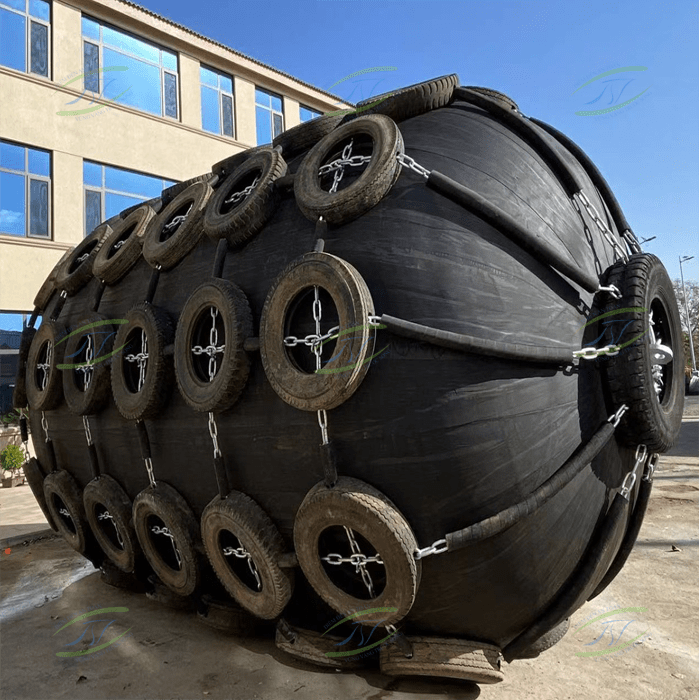Pneumatic Fender (Marine Air Fender)
Pneumatic Fender, also known as Viet Nam rubber, is a widely used marine fender system designed to protect ships and port structures from impact during berthing, mooring, or cargo operations. Using compressed air as a cushioning medium, pneumatic fenders offer excellent shock absorption and structural protection.
Structure of Pneumatic Fender
- Outer Rubber Layer
- Made of natural or synthetic rubber, highly resistant to seawater corrosion and external impacts.
- Reinforced with synthetic tire-cord layers to increase mechanical strength and elasticity.
- Inner Air Layer
- Compressed air inside absorbs and distributes energy upon impact.
- Protective Net (optional)
- Some fenders are covered with chain-net and tires or polyester nets to improve durability and resistance in harsh marine environments.
- Air Valve
- Designed for inflation and deflation to maintain optimal internal pressure based on vessel size and application.
Working Principle
When a vessel makes contact, the internal air compresses, dispersing the impact energy across multiple directions. This minimizes damage to the ship and quay structure, while the rebound force stabilizes berthing operations and ensures safety.
Nguyen Tai Co., Ltd. proudly provides Pneumatic Fender solutions that comply with PIANC, ISO, and DNV standards. Our products ensure a long service life (5–15 years depending on operating conditions) with strict quality control in production.
Accessories for Pneumatic Fenders
Technical Specifications
Dimensions & Performance of Pneumatic Fender (50 kPa)
| Nominal Size (Diameter x Length, mm) | Initial Internal Pressure | Guaranteed Energy Absorption (GEA, kJ) | Reaction Force at GEA (KN) | Hull Pressure at GEA (kPa) |
|---|---|---|---|---|
| 500 × 800 | 50 kPa | 6 | 63 | 130 |
| 500 × 1000 | 50 kPa | 6 | 64 | 132 |
| 600 × 1000 | 50 kPa | 8 | 74 | 126 |
| 1000 × 2000 | 50 kPa | 45 | 257 | 132 |
| 1500 × 2500 | 50 kPa | 134 | 499 | 131 |
Installation Guide for Pneumatic Fenders
Step 1: Preparation
- Inspect the fender: Ensure no defects and check air pressure (50–80 kPa).
- Prepare installation tools: ropes, chains, shackles, and connecting accessories.
- Check quay/ship structure: Ensure strength to handle fender loads.
Step 2: Positioning
- Select positions based on vessel size and berthing area.
- Maintain appropriate spacing between fenders for optimal energy absorption.
Step 3: Installation
- Secure fenders using chains or ropes to quay or ship.
- Check mooring points for safety and stability.
- Install chain-net protection if required.
Step 4: Post-installation Check
- Re-check air pressure and adjust if necessary.
- Conduct berthing trials to test impact resistance.
Step 5: Maintenance
- Inspect fenders regularly for damage, chain wear, and air pressure.
- Clean and repair periodically to ensure long service life.
Completed Projects
- K662 Oil Depot – Military Petroleum General Depot: NT – CSS 1000H, 1250H
- Defense Port Renovation – Military Zone 7: NT – CSS 800H
- Bac Van Phong Port: NT – CSS 1150H
- Song Hau 1 Thermal Power Plant – Package BS04: NT – CSS 1000H, 1250H
- Hoa Phat Steel Port: NT – CSS 1250H
- Chu Lai – Truong Hai Port: NT – CSS 1450H
Marine Fender Solutions
Related products for port protection:
- Lambda Fender
- Cone Fender (SPC)
- Cylindrical Fender
- PPI Fender
- Mooring Bollards
- Rubber Ladders
Contact Us
For quotations and technical support, please contact:
Nguyen Tai Co., Ltd – Manufacturer and distributor of marine fenders and mooring bollards.
📍 Address: 310C Nguyen Thi Lang, Cu Chi, Ho Chi Minh City
📞 Hotline: +84972 491 224
📞 Hotline: +84 97 421 5855
✉️ Email: nguyentairubber@gmail.com kd.nguyentai@gmail.com
🌐 Website: nguyentairubber.com
